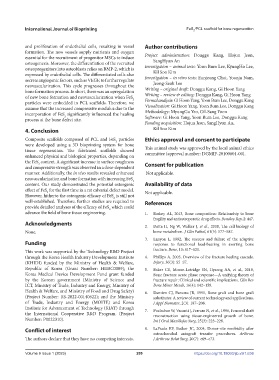Page 217 - IJB-9-1
P. 217
International Journal of Bioprinting FeS /PCL scaffold for bone regeneration
2
and proliferation of endothelial cells, resulting in vessel Author contributions
formation. The new vessels supply nutrients and oxygen Project administration: Donggu Kang, Hojun Jeon,
essential for the recruitment of progenitor MSCs to induce SangHyun An
osteogenesis. Moreover, the differentiation of the recruited Investigation – animal tests: Yoon Bum Lee, KyungHo Lee,
osteoprogenitors into osteoblasts relies on BMP-2, which is Kil Soo Kim
expressed by endothelial cells. The differentiated cells also Investigation – in vitro tests: Eunjeong Choi, Yoonju Nam,
secrete angiogenic factors, such as VEGF, to further regulate Jeong-Seok Lee
neovascularization. This cycle progresses throughout the Writing – original draft: Donggu Kang, Gi Hoon Yang
bone formation process. In short, there was an upregulation Writing – review & editing: Donggu Kang, Gi Hoon Yang
of new bone formation and neovascularization when FeS Formal analysis: Gi Hoon Yang, Yoon Bum Lee, Donggu Kang
2
particles were embedded in PCL scaffolds. Therefore, we Visualization: Gi Hoon Yang, Yoon Bum Lee, Donggu Kang
assume that the increased compressive modulus due to the Methodology: MyungGu Yeo, Gil-Sang Yoon
incorporation of FeS significantly influenced the healing Software: Gi Hoon Yang, Yoon Bum Lee, Donggu Kang
2
process at the bone defect site.
Funding acquisition: Hojun Jeon, SangHyun An,
4. Conclusion Kil Soo Kim
Composite scaffolds composed of PCL and FeS particles Ethics approval and consent to participate
2
were developed using a 3D bioprinting system for bone
tissue regeneration. The fabricated scaffolds showed This animal study was approved by the local animal ethics
enhanced physical and biological properties, depending on committee (approval number: DGMIF-20100801-00).
the FeS content. A significant increase in surface roughness Consent for publication
2
and compressive strength was observed in a dose-dependent
manner. Additionally, the in vivo results revealed enhanced Not applicable.
neovascularization and bone formation with increasing FeS
2
content. Our study demonstrated the potential osteogenic Availability of data
effect of FeS for the first time in a rat calvarial defect model. Not applicable.
2
However, hitherto the osteogenic efficacy of FeS is still not
2
well-established. Therefore, further studies are required to References
provide detailed analyses of the efficacy of FeS which could
2
advance the field of bone tissue engineering. 1. Boskey AL, 2013, Bone composition: Relationship to bone
fragility and antiosteoporotic drug effects. Bonekey Rep, 2: 447.
Acknowledgments
2. Datta H, Ng W, Walker J, et al., 2008, The cell biology of
None. bone metabolism. J Clin Pathol, 61(5): 577–587.
3. Lanyon L, 1992, The success and failure of the adaptive
Funding response to functional load-bearing in averting bone
This work was supported by the Technology R&D Project fracture. Bone, 13: S17–S21.
through the Korea Health Industry Development Institute 4. Phillips A, 2005, Overview of the fracture healing cascade.
(KHIDI) funded by the Ministry of Health & Welfare, Injury, 36(3): S5–S7.
Republic of Korea (Grant Number: HI18C0089); the 5. Baker CE, Moore-Lotridge SN, Hysong AA, et al., 2018,
Korea Medical Device Development Fund grant funded Bone fracture acute phase response—A unifying theory of
by the Korean government (Ministry of Science and fracture repair: Clinical and scientific implications. Clin Rev
ICT, Ministry of Trade, Industry and Energy, Ministry of Bone Miner Metab, 16(4): 142–158.
Health & Welfare, and Ministry of Food and Drug Safety) 6. Damien CJ, Parsons JR, 1991, Bone graft and bone graft
(Project Number: RS-2022-00140622); and the Ministry substitutes: A review of current technology and applications.
of Trade, Industry and Energy (MOITE) and Korea J Appl Biomater, 2(3): 187–208.
Institute for Advancement of Technology (KIAT) through 7. Puelacher W, Vacanti J, Ferraro N, et al., 1996, Femoral shaft
the International Cooperative R&D Program. (Project reconstruction using tissue-engineered growth of bone.
Number: P0022310). Int J Oral Maxillofac Surg, 25(3): 223–228.
Conflict of interest 8. LaPrade RF, Botker JC, 2004, Donor-site morbidity after
osteochondral autograft transfer procedures. Arthrosc
The authors declare that they have no competing interests. J Arthrosc Relat Surg, 20(7): e69–e73.
V
Volume 9 Issue 1 (2023)olume 9 Issue 1 (2023) 209 https://doi.org/10.18063/ijb.v9i1.636

